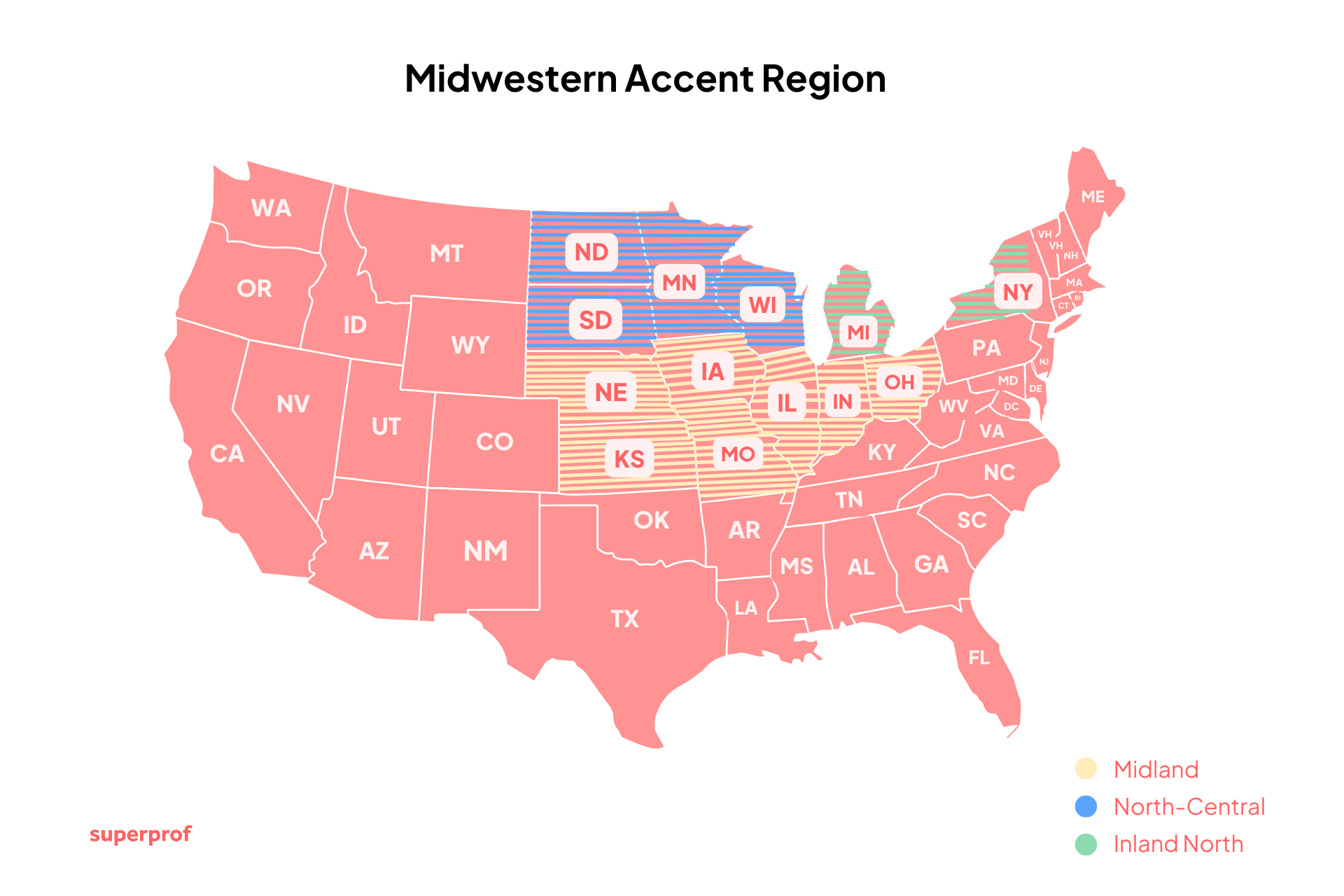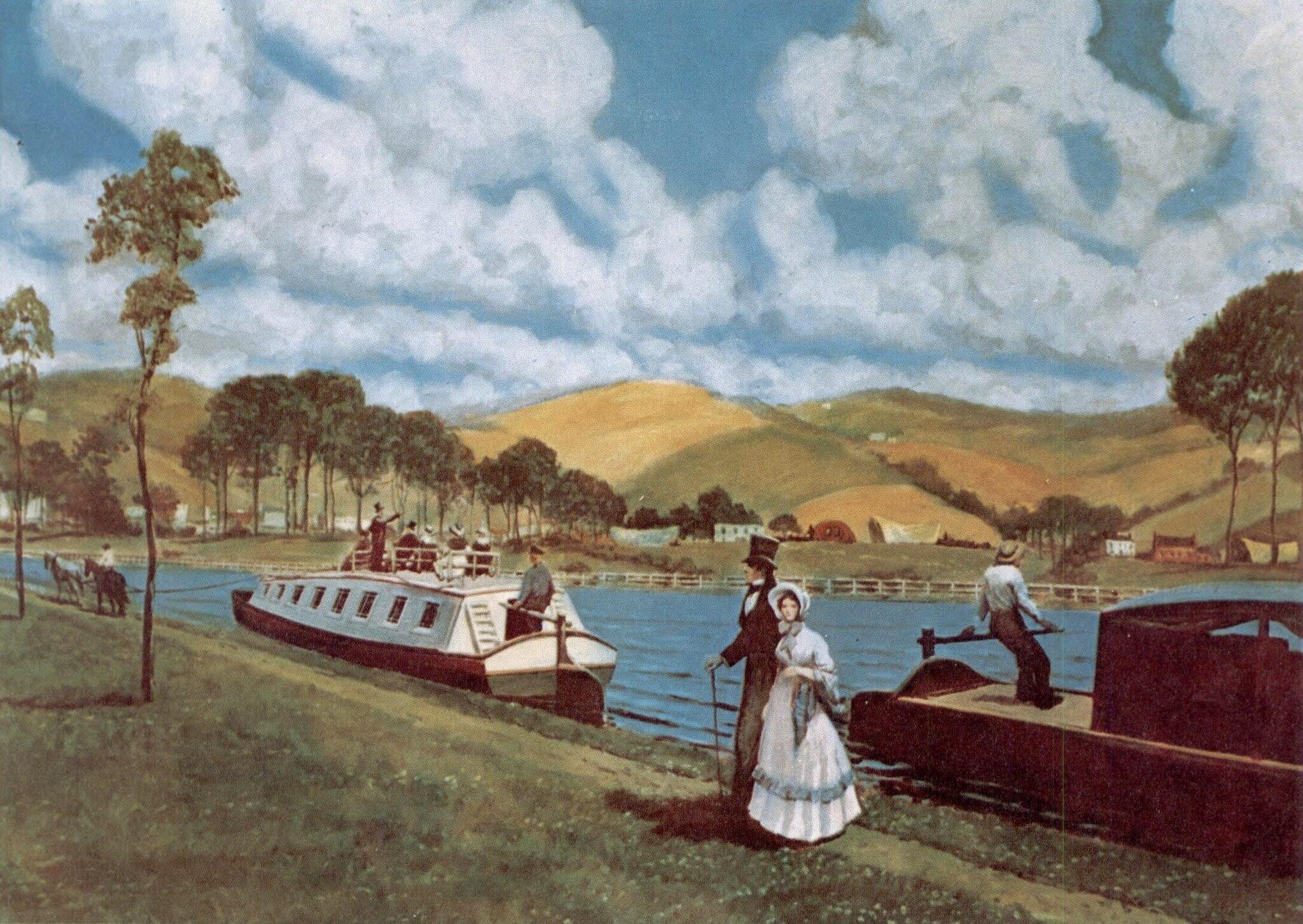One of the broadest linguistic regions in the United States is the Midwest. Although each state has its differences in pronunciation and dialect, the Heartland states generally have a similar-sounding take on the English language. Learn more about this sometimes-neutral, sometimes-not set of regional accents found in the American Midwest!

Where Is the Midwest Accent Spoken?
As the name suggests, the accent is found mainly in the middle (mid) part of the country in an East-West orientation.
The area now known as the Midwest was, back in the 18th and 19th centuries, when America was developing under colonialism. The colonies and settlers slowly expanded from the East, where the first settlements were established. Since the West coast of the continent was largely unknown, and the United States’ territory didn’t reach it anyway, they called the westernmost territories The West (or The Heartland).
A Yooper is someone from the Upper Peninsula of Michigan. Can you see where the name came from? Upper Peninsula is abbreviated as “U.P.” which is pronounced like “Yoo pea,” or “yoop” for short. Hence: Yooper!
After Manifest Destiny became more popular and large swaths of people were moving out to California and similar areas, the West was re-named as the Midwest, since it was no longer the westernmost part of the nation.
Today, the US Census Bureau considers the American Midwest to consist of these 12 states:
- Illinois
- Indiana
- Iowa
- Kansas
- Michigan
- Minnesota
- Missouri
- Nebraska
- North Dakota
- Ohio
- South Dakota
- Wisconsin
You’ll notice that the articulation can also be found in a prominent Northeastern state as well: New York! But did you know there are also pockets of the Midwest accent found in Pennsylvania, Alaska, Florida, and Texas? We’ll get into the history of why that is in the next section.
It’s also important to note that the English Midwestern accent is different from the General American Accent (although many people living in the Heartland possess the GAA instead of a Midwestern pronunciation). As an ESOL learner, it can be especially difficult to notice the subtle differences between the two types, since they share a lot of similarities. With practice and a keen ear, you’ll be able to pick up on these tiny differentiations over time.

Various Midwestern Dialects
Just like in the South, there are many variants of the Midwestern pronunciation to be found.
There are dozens spread across the area, since highly regional accents and dialects are part and parcel of any population. However, there are three main variants to know.
Midland American English
Found mostly in Illinois, Indiana, Iowa, Kansas, Missouri, Nebraska, and Ohio, the Midland accent is the predominant accent in the region. Its most distinctive features are the affected “a” sound and the intrusive “r” (which, interestingly, is only found in a small handful of words but is striking enough to be one of the main characteristics of the pronunciation).
Inland Northern American English
The Inland accent is concentrated in Michigan, with upstate New York sharing some of the spotlight. It’s very similar to the GAA except for a few notable aspects, mostly the shifted vowel sounds and vocabulary.
A notable exception: The Yooper accent is a very different dialect which is much heavier, and sounds more like the North Central accent.
North Central American English
Concentrated in Minnesota, North Dakota, South Dakota, and Wisconsin, the North Central accent is a little more pronounced than its Midwestern counterparts. It’s most recognizable for its affected vowel sounds and changed pronunciations.
History of the Midwestern Accent
The United States has had several waves of immigrants over the years, especially in the 16th to 20th centuries. In the 18th and 19th centuries, many more Scandinavian and German immigrants started coming to the county, just as westward expansion was taking place. As a result, these immigrants traveled in droves to the newer States, where they could work on building communities without having to navigate around existing multicultural frameworks.
Of course, over time, these communities learned English and integrated into the community at large. But the Scandinavian and German influences are still heard in the way their descendants speak!
It’s also hypothesized that Scots-Irish immigrants influenced the dialect as well, but that long-standing theory has been challenged in recent years.

Other elements that have played a role in modern-day Midwestern speech include Indigenous populations’ and early French explorers' pronunciations. In the cities, the influx of African American folks from elsewhere in the US has created a distinct metropolitan dialect touched by AAVE (African American Vernacular English), especially in large cities like Detroit and Chicago.
Like all the other accents and dialects in the world, the Midwestern inflection is living and therefore, changing.
Why is the English Midwest pronunciation found in places outside of the Heartland? The Inland North accent corresponds with a region of the US called the Rust Belt, where industry took hold during the Industrial Revolution (and subsequently declined). These areas attracted many of those Scandinavian and German immigrants mentioned earlier.

Thanks to the Erie Canal, it was easy for travelers to go to and from Rochester, Syracuse, and Buffalo in New York to the Great Lakes ports of Cleveland, Detroit, Chicago, and Milwaukee. So, the English Midwest accent actually came from New York originally!
As for Alaska, in the 1930s, 203 families from the Midwest traveled to the Matanuska Valley as part of the New Deal, in an attempt to help struggling farmers relocate to a new rural area to simultaneously cultivate the land for the US and rebuild their lives after the Great Depression.
As for Florida, the shift in pronunciation in the panhandle of the state is due to the large number of northern transplants who migrate to the Sunshine State from the cold Northeast and Midwest regions.
The Midwestern accent and the General American English Accent (aka General American Accent) share a lot of similarities. In many areas of the country, you can find variations of both of these accents that overlap so much that it can be hard to tell which articulation you’re hearing! Midwestern inflections can be found beyond the Midwestern states. For example, Pennsylvania, New York, Appalachia, and pockets of Florida exhibit some Midwestern accent features.

Characteristics of Midwest Accents
As we’ve seen, there are several Midwest accents, each with their own unique features. So, we will be covering the general features of the Midwestern pronunciation as a whole.
The hallmark aspects of the regional dialects are:
Rhoticity
The easiest thing to notice about this articulation is its rhoticity, that is, that the “r” sound is consistently pronounced no matter where it appears in a word. Contrast this with many other US accents, such as certain Southern varieties or those found in the Northeast, which are non-rhotic (think of the Boston or New York City accent).
Cot-Caught Merger & Vowel Flattening and Shifting
Varying in prevalence in different regions, these striking features of the English Midwest inflection often give Northern speakers that “Canadian” flair. Depending on the word and the type of articulation used, many speakers pronounce words with similar vowels the same, as in “nod” and “gnawed.”
The “o” and “a” sounds in words are also often flattened and elongated, so words like “about” and “bag” turn into “abot” and “bayg.”
Intrusive S
Many Midwesterners will add an “s” at the ends of words that don’t really have them, especially a possessive “s” on shop names. For example, Meijer is a popular grocery store in the region. It’s common for people to call it “Meijer’s” instead.
Intrusive R and Linking R
Midwesterners love their “r” sounds, they even add them in places they don’t really belong!
Certain words often receive an extra “r” within, the most famous example being “warsh” instead of “wash.”
Additionally, to make the cadence of speaking smoother, certain words might get an added “r” at the end, for example, instead of “I saw a movie,” someone might say “I sawr a movie.”

Altered Pronunciation
Certain sounds are shifted altogether. You’ll notice it mostly with words ending in “-ing” because the pronunciation usually shifts to “-een.” So, words like “sleeping” and “driving” sound like “sleepeen” and “driveen.”
“Th” Deletion
In some variations of the pronunciation, the “th” sound, especially at the beginning of words, gets turned into a “d” sound. So “there,” “them,” and “those” become “dere,” “dem,” and “dose.” This feature is often found in the Yooper Midwestern dialect.
Dialectical Sentence Structure
In some regions, folks might structure their sentences in entirely different ways than most other Americans. This is because of the Scandinavian, German, etc influences of the region in the past. Commonly, a verb is placed in a different place, which can lead to confusion for those unfamiliar with the practice. For example, instead of “Can I borrow a book from you?” someone might say “Can you borrow me a book?”
Another common occurrence is deleting “to be” from sentences, for example, “That needs to be washed” becomes “That needs washed.”
Midwest Phrases & Vocabulary
While it’s impossible to name every Midwesternism (and pinpoint exactly which states do and do not use specific ones), there are a few you should know in case you run into someone from the region. Even folks from different parts of the US might find the pronunciation and lexicon confusing at times, especially because of the unique sentence structures and vowel sounds that appear in certain Midwestern accents.
Here are some of the most common words and phrases to know when you hear a Midwest dialect.
| Word or Phrase | Pronounciation | Meaning | Example |
|---|---|---|---|
| Anymore | Anymore | these days, nowadays (can also be used to mean "anymore" in the usual way) | I'm trying to use less plastic anymore. |
| Batteries | bat-chrees | Batteries | Can you borrow me some batteries? |
| Eh | ayh | a tag question to convey interest or agreement | "It's cold today, eh?" "Interesting shoes you got there, eh?" |
| Hotdish | Hot dish | casserole | I brought over some hotdish! |
| Jeet | Jeet | "Did you eat" > "Didja eat" > "Jeet" | Hi, come on in, thanks for stopping by! Jeet? |
| Ope | Owp | Oops; watch out; excuse me | Ope! I'm right behind ya there! |
| Pop | pop or pawp (depending on region) | Soda | Can I get you a drink? Pop? |
| Stop-n-go lights | Stop-n-go lights | Traffic lights, stop lights | Sorry I'm late, the stop-n-go lights were busted and I got stuck in traffic! |
The Heartland is an interesting linguistic region. The General American Accent is based on certain iterations of the Midwest way of speaking, but others sound incredibly different and decidedly UN-general! Many people agree it's a fun pronunciation to learn and mimic because of its interesting vowel sounds.
Learning the Midwest accent is a great way to expand your understanding of US linguistics!
References
- Documentary on Alaska’s Great Depression farm colonists worth watching. (n.d.). In Anchorage Daily News. https://www.adn.com/commentary/article/documentary-alaskas-great-depression-farm-colonists-worth-watching/2013/06/08
- HISTORY com Editors. (2009). Westward Expansion - Timeline, Events & Facts. In HISTORY. https://www.history.com/articles/westward-expansion
- Let’s Travel Through Some Midwest Accents, Eh? (n.d.). In Chicago Magazine. https://www.chicagomag.com/arts-culture/lets-travel-through-some-midwest-accents-eh
- Understanding the American Midland Accent. (n.d.). In Dynamic Language. https://www.dynamiclanguage.com/understanding-the-american-midland-accent
- Why the Chicaaaaago Accent Is Really a New York One. (n.d.). In Chicago Magazine. https://www.chicagomag.com/city-life/chicago-accent-erie-canal-vowel-shift















